PDFWAC 246-260-031
General design, construction, and equipment for all WRF pool facilities.
(See additional design and construction requirements for swimming pools in WAC 246-260-041, for spa pools in WAC 246-260-051 and 246-260-061, for wading pools in WAC 246-260-071, for spray pools in WAC 246-260-081 and for specialty design conditions in WAC 246-260-091. See chapter 246-262 WAC for specific requirements for water park type features.)
(1) Location: Owners shall locate pools to minimize surface drainage and other potential sources of pollution from entering the pool.
(2) Materials: Owners shall use only structure and equipment materials that are nontoxic, durable, inert, and easily cleanable.
(3) Walking surfaces: Owners shall design and maintain walking surfaces:
(a) Sloping away from the pool or pools;
(b) Sloping a minimum of one-fourth inch per foot to drain;
(c) Having a nonslip finish;
(d) Not having an abrupt change in height of greater than one-half inch, a gap no greater than one-half inch in width, or a crumbling surface presenting a potential tripping hazard;
(e) Equipped with sufficient drains to prevent standing water; and
(f) Of easily cleanable, impervious finishes.
(4) Barriers for new construction and remodeling:
(a) Owners shall provide barriers to prevent unauthorized persons from gaining access to pools. Spray pool facilities without standing water are exempt from barrier requirements of this section.
(b) Barriers at limited use pools must be at least sixty inches high.
(c) Barriers at general use pools must be at least seventy-two inches high.
(d) Barriers, including windows, (see figures 031.1 and 031.2) may not:
(i) Allow passage of a four-inch diameter sphere; or
(ii) Have spaces between vertical members greater than a width of one and three-quarter inches if the distance between the tops of horizontal members are spaced less than forty-five inches apart.
(e) Solid barriers may not have indentations or protrusions, other than normal construction tolerances and masonry joints.
(f) Barriers must have self-closing, self-latching gates or doors that provide either:
(i) A mechanism that uses a continuously locked latch, coded lock or other equivalent access control system that always requires a key or code to enter pool area. If the latch is less than sixty inches from the ground, the barrier must have an eighteen-inch radius of solid material around the latch (see figure 031.2) to preclude a child on the outside of the barrier from reaching through the gate or barrier and opening the latch and entering the pool; or
(ii) A latch height of sixty inches or more from the ground.
(g) Restricted area service entrances are exempt from door or gate requirements provided that no public access is available.
(h) Lifeguarded pools are not required to have a self-closing, self-latching gate during the period a pool is in use. Facility gates shall be closed and locked during nonuse periods.
(i) Barrier heights are measured on the side outside the pool enclosure area. Owners shall ensure that surrounding ground levels, structures, or landscaping do not reduce the effective height of the barrier.
Figure 031.1
Barrier Construction Detail
(a). For a Chain Link Fence:
The mesh size shall not exceed 1 1/4 inches square.
 |
(b). When chain link exceeds 1 1/4 inches square, provide slats to reduce mesh openings to no more than 1 3/4 inches.
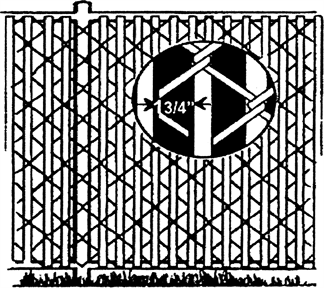 |
(c). Vertical Spacing: If tops of horizontal members are greater than 45 inches apart, vertical spacing shall not exceed 4 inches.
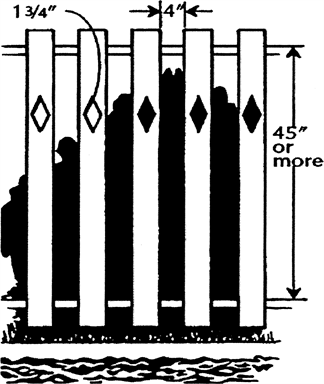 |
(d). Vertical Spacing: If tops of horizontal members are less than 45 inches apart, vertical spacing shall not exceed 1 3/4 inches.
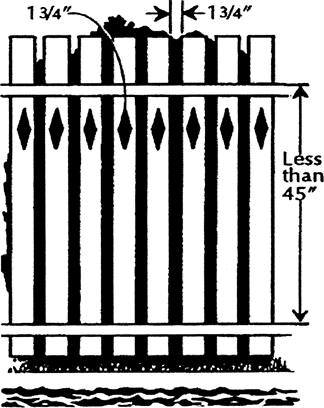 |
(e). Solid Barrier: No indentations or protrusions shall be present, other than normal construction tolerances and masonry joints.
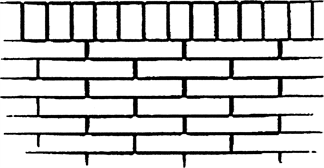 |
(f). Maximum Clearance shall not exceed 4 inches above grade.
 |
Figure 031.2 Gate and Latch Detail: When latch height is less than 60 inches from the ground, a continuously locked lock must be provided with an 18 inch radius of protection around the latch.
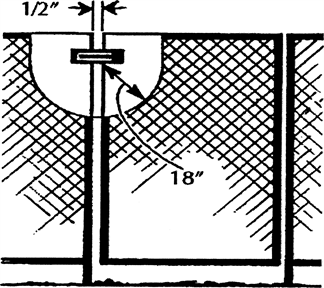 |
(5) Barriers for existing facilities: Before June 1, 2008, owners shall provide barriers for all pools conforming with subsection (4) of this section. Barrier modifications made prior to the compliance deadlines shall meet the requirements in subsection (4) of this section, at the time the modifications are made.
(6) Pool surface: Owners shall ensure pool surfaces are constructed and maintained to:
(a) Have white or light color finish;
(b) Not cause cutting, pinching, puncturing, entanglement, or abrasion hazard under casual contact; and
(c) Conform to ANSI/NSPI-1 2003 Standards for Public Swimming Pools or ANSI Standard NSPI-@-1999, American National Standard for Public Spas.
(7) Inlets: Owners shall provide pool inlets that are:
(a) Submerged;
(b) Located to produce uniform water and chemical circulation throughout the pool; and
(c) Located on the bottom of swimming and wading pools over twenty-five hundred square feet and spa pools greater than ten thousand gallons.
(8) Outlets:
(a) Except as provided in (f) and (g) of this subsection, owners shall provide pool outlets with:
(i) Overflow and main drain systems each designed to carry one hundred percent of the total recirculation filter flow;
(ii) Main drain piping systems designed to carry one hundred percent or more of total recirculation filter flow when a single pump is used or fifty percent or more of total recirculation filter flow when multiple pumps are used; and
(iii) Valving on main drain piping designed to provide required flow.
(b) Owners shall ensure that overflow outlets maintain a minimum of sixty percent of filter recirculation flow at all times.
(c) Overflow outlets must consist of an overflow channel on the perimeter of swimming pools twenty-five hundred square feet or more and spa pools ten thousand gallons or more, to promote uniform circulation and skimming action of the upper water layer with:
(i) A design preventing all matter entering the channel from returning to the pool;
(ii) Dimensions minimizing the hazard for bathers, such as catching arms or feet;
(iii) One one-hundredth of a foot slope per foot or more. However, adequate hydraulic justification from a designer to ensure the overflow system will meet (c)(v) of this subsection may be provided as an alternative;
(iv) Drains sufficiently spaced and sized to collect and remove overflow water to return line and filter, where applicable; and
(v) Size sufficient to carry one hundred percent of the recirculation flow plus the surge flow without flooding the overflow channel.
(d) Overflow outlets must consist of skimmers or overflow channels for pools less than twenty-five hundred square feet, or for spas under 10,000 gallons.
(i) Weirs provided in skimmers must have a normal operation flow rate of three to five gpm per inch of weir;
(ii) Skimmer equipment must be recessed in the pool wall so no part protrudes beyond the plane of the wall into the pool;
(iii) Skimmers must be equipped with a device, such as an equalizer line, to prevent air lock in the recirculation suction line. If equalizer lines are used, they must be protected with a suction outlet that conforms to the suction fitting standard;
(iv) Skimmers must be equipped with a removable and cleanable screen designed to trap large solids;
(v) Skimmers shall operate continuously with a minimum displacement rate of fifteen gallons per bather in swimming pools, twenty gallons in spa pools, and seven gallons in wading pools.
(e) Main drains in all pools must:
(i) Be located at swimming and wading pool low points;
(ii) Have piping designed so velocity in piping assuming one hundred percent of the pump recirculation flow does not exceed six fps up to the main drain outlet box;
(iii) Have covers on main drains with maximum flow of one and one-half feet per second;
(iv) Consist of two or more main drains for any pumped water recirculating system designed;
(A) Piping must be manifolded with junction fittings placed in the middle of branch line piping between main drains, so that the length of branch line piping is equal on each side of the junction fitting (see Figure 031.3);
Figure 031.3
Main Drain Branch Line Piping Detail
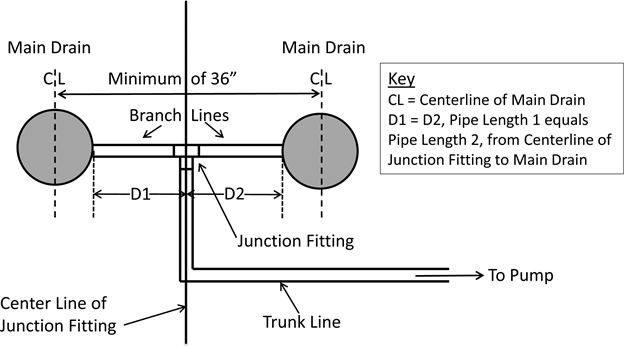 |
(B) Main drains must be spaced at least three feet apart, measured between the centers of the drain covers;
(C) Main drains must conform to the suction fitting standard;
(D) Multiple main drains must be designed so that if one main drain becomes blocked, the remaining main drains are rated to at least one hundred percent of the maximum pump flow; see Table 031.4.
Table 031.4
Main Drain Flow Rating Requirements
Number of Main Drains Per Recirculation System | ||||
2 | 3 | 4 | 5 | |
Main drain rated flow capacity must be at least equal to the percent of maximum pump flow indicated, depending on the number of main drains. | 100% | 50% | 33.3% | 25% |
(f) Existing water recreation facilities may be modified to operate without main drains, provided that water quality and water clarity standards established in WAC 246-260-111 are met.
(g) New water recreation facilities may be constructed without main drains, provided that water quality and water clarity standards established in WAC 246-260-111 are met.
(9) Pumps: Owners shall provide and maintain recirculation pumps with adequate capacity to provide design flows for the entire operating and backwash cycles of the filter.
(10) Strainers: Owners shall provide hair and lint strainers for pumps that precede filters.
(11) Pool appurtenances:
(a) Owners shall ensure pools have:
(i) Handholds when the pool deck is greater than twelve inches above the water surface;
(ii) Stairs leading into spa pools;
(iii) Step risers on the exterior of the spa pool shall conform with UBC requirements for risers with nonslip tread finishes, when spas are elevated off the pool floor; and
(iv) Stairs, ladders, or stepholes for access at the shallow end of swimming pools.
(b) Owners shall ensure that stairs, when provided, meet the following construction requirements:
(i) Nonslip tread finish;
(ii) Contrasting color stair tread edges;
(iii) Placement recessed into the side of pools specifically designed for lap or competitive swimming;
(iv) Handrail having leading edges less than eighteen inches beyond and less than eight inches inside (horizontally) the vertical plane of the bottom riser;
(v) Each riser tread shall have a minimum unobstructed, tread depth of ten inches and minimum surface area each of two hundred forty inches;
(vi) Uniform riser heights of seven and one-half inches or less on general use swim pools fifteen hundred square feet or more and spa pools greater than forty feet in perimeter, except the bottom riser may be less than the uniform height; and
(vii) Uniform riser heights of ten inches or less for all other pools, except the bottom riser may be plus or minus two inches of the uniform height.
(c) Ladders or stepholes at swimming pools shall be:
(i) Spaced at a minimum of one for every seventy-five feet of swimming pool perimeter deeper than four feet;
(ii) Provided at both sides of the deep end of swim pools over thirty feet in width; and
(iii) Equipped with handrails.
(12) Valves: Owners shall provide valves to allow isolation and maintenance of equipment.
(13) Balancing tanks: Owners shall provide balancing tanks for pools designed with overflow channels. Balancing tanks must be of adequate size to prevent air lock in the pump suction line and have sufficient capacity to prevent flooding of the overflow channel.
(14) Equipment and chemical storage rooms: Owners shall provide enclosed, locked, lighted, vented rooms for mechanical equipment, with floors sloped to a floor drain and minimum access area three feet wide around equipment. Owners shall provide a separate chemical storage area or room that conforms to manufacturer's requirements for each chemical used in the pool area.
(15) Make-up water: Owners shall ensure an adequate supply of make-up water with associated piping, for each pool:
(a) Sufficient to replace daily pool losses;
(b) From a supply conforming to chapter 246-290 WAC;
(c) Without cross connections; and
(d) If using a pool fill spout, the spout may not project greater than one inch into the space above the water surface and shall be shielded so as not to create a deck hazard.
(16) Filters:
(a) Owners shall equip pools with filtration equipment:
(i) Meeting the applicable standards of NSF (for commercial application) or equivalent;
(ii) With a rate of flow indicator and gauge(s) for monitoring backpressure on filter;
(iii) With a means of discharging filter backwash to waste with a sight glass in a manner not creating a cross connection or a public nuisance;
(iv) With a means to release air entering the filter tank for pressure filters.
(b) If cartridge filters are used, owners shall always possess an extra set of cartridges and may not use cartridge filters with bypass valves.
(17) Disinfection equipment:
(a) Owners shall provide disinfection equipment:
(i) Providing a continuous and effective disinfectant residual;
(ii) Using a disinfectant with an easily monitored residual;
(iii) Having a design feed rate providing effective disinfection levels for peak demand conditions; and
(iv) Conforming to NSF standard 50 if disinfection chemical is other than gas chlorine.
(b) If disinfection equipment has adjustable output rate chemical feed of liquid solutions, the equipment shall:
(i) Feed under positive pressure in the recirculation system;
(ii) Provide a means for dosage adjustment; and
(iii) If the disinfection equipment is above pool water surface level, have provisions to prevent disinfectant solution siphoning when equipment is turned off.
(c) Solid tablets or granules may not be placed in skimmer basket.
(d) Rooms holding chlorine gas equipment must:
(i) Be above ground level;
(ii) Be constructed so all openings or partitions with adjoining rooms are sealed;
(iii) Be located with consideration of prevailing winds to dissipate leaked chlorine away from the pool facility;
(iv) Have door(s) opening only outward to the out-of-doors; and
(v) Have a sign on the door exterior reading danger chlorine in large enough letters to be read twenty-five feet away.
(e) Chlorine rooms must have mechanical exhausting ventilation that includes:
(i) Air inlets located as far as possible from fan intakes to promote good air circulation patterns;
(ii) A minimum of one air change per minute in the chlorine room when fan is operating;
(iii) A remote switch outside the room or a door-activated switch to turn on fan before entering;
(iv) Suction for fan near the floor;
(v) Exhaust vents located to prevent chlorine contaminated air from being drawn into supply air; and
(vi) Screened chlorinator vents.
(f) Gas chlorine systems must:
(i) Be vacuum injection type, with vacuum-actuated cylinder regulators;
(ii) Provide integral backflow and antisiphon protection at the injector;
(iii) Have taring (net weight of cylinder gas) scales for determining chlorine weight; and
(iv) Have a means for automatic shutoff when water flow is interrupted.
(g) A self-contained breathing apparatus designed for use in chlorine atmospheres caused by chlorine leaks must be available in an area accessible to the operator outside the chlorine room. The apparatus must be maintained in accordance with department of labor and industry standards. If procedures are established for immediate evacuation and the owner has a written agreement with emergency service fire districts or other approved organizations within the area for promptly responding to chlorine leaks, then breathing protection is not required at the pool facility.
(h) Chlorine gas cylinders must:
(i) Be stored only in designated chlorine rooms;
(ii) Have an approved valve-stem cylinder wrench on the valve stem to shut the system down in an emergency event;
(iii) Be properly secured to prevent tipping;
(iv) Be tagged to indicate cylinders are empty or full; and
(v) Not exceed one hundred fifty pounds tare weight per cylinder.
(i) Owners shall ensure that chemical disinfectants are not hand-fed into pools actively in use. Exception, chemical disinfectants may be hand-fed on an emergency basis if no users are in the pool and the pool is tested to meet water quality standards before reentry.
(j) If ozone is provided as a supplemental disinfection process:
(i) When ozone is produced by corona discharge method, the area where the ozone is produced shall meet the requirements of (e) of this subsection, unless field tests demonstrate no hazardous off-gassing of product;
(ii) When ozone is produced by ultraviolet light, it may be allowed in the mechanical room provided there are no levels of off-gassing exceeding 0.05 ppm;
(iii) Provide an ozone detector and alarm with corona discharge ozone generators;
(iv) Provide sufficient contact chambers to prevent excess levels of ozone from entering the pool water; and
(v) Testing equipment must be provided to monitor levels in the water and the atmosphere immediately above the water and the room where the ozone is produced.
(k) If copper or copper/silver is provided as a supplemental disinfection process:
(i) The output rate and method of controlling process levels into the pool facility must be provided;
(ii) The system shall not have a detrimental effect on maintaining proper turnover rates for the pool; and
(iii) Testing equipment provided to monitor levels of copper and silver in the pool water.
(18) Chemical feeding equipment for pH control: Owners shall provide chemical feed equipment for pH control, with a means of automatic shutoff if water flow is interrupted, for:
(a) Swimming pools fifty thousand gallons or greater;
(b) Spa pools ten thousand gallons or greater; and
(c) All pools treated with caustic soda or carbon dioxide.
(19) Ventilation: Owners shall provide adequate ventilation (in conformance with ASHRAE standards for pools and decks) to maintain air quality and to prevent moisture buildup in indoor areas. Design considerations must include maintaining negative pressure in the pool and deck area; providing adequate total airflow for acceptable air distribution; and preventing short-circuiting of fresh air return to exhaust.
(20) Locker room and dressing rooms:
(a) Owners shall provide general use pool facilities with locker rooms and dressing rooms having:
(i) Separate facilities for each gender constructed to block line of sight into locker rooms;
(ii) Water impervious nonslip floors properly sloped to drains to prevent standing water;
(iii) Easily cleanable walls, lockers, and benches (if provided);
(iv) Junctions between walls and floors coved for ease of cleaning; and
(v) Properly anchored lockers, (if provided), to prevent tipping.
(b) Owners shall provide limited use pool facilities with locker or dressing rooms meeting the requirements of (a) of this subsection if the pool facilities are located more than one-quarter mile from any served living units.
(c) Owners shall provide general use recirculating spray pool facilities with locker or dressing rooms meeting the requirements of (a) of this subsection if the pool facilities are located indoors.
(21) Restrooms, shower rooms, and plumbing fixtures:
(a) Owners shall provide general use pool facilities with restroom and shower room facilities having plumbing fixture types and numbers as described in Table 031.5 of this section (swim and wading pool bathing loads and spa bather capacity are additive for determining total bather load). The pool facility design shall provide users easy access to restroom and shower facilities with minimum nonuser cross traffic.
(b) Owners shall provide general use pool facilities with:
(i) Hose bibs with vacuum breakers around pool decks at a maximum spacing of one hundred fifty feet; accessible to each locker room; and within equipment room at facilities fifteen hundred square feet or more;
(ii) A janitor's sink at indoor facilities with a pool of fifteen hundred square feet or more; and
(iii) An operable drinking fountain conforming to ASA requirements at facilities with a pool fifteen hundred square feet or more.
(c) Owners shall provide limited use pool facilities with:
(i) Restroom and shower room facilities having plumbing fixture types and numbers as described in Table 031.5 of this section, if bathing load exceeds eighty persons;
(ii) Restroom and shower room facilities having plumbing fixture types and numbers as described in Table 031.6 of this section, if bathing load is eighty persons or less;
(iii) Hose bibs around pool decks at a maximum spacing of one hundred fifty feet;
(iv) A hose bib accessible to each locker room; and
(v) A hose bib within each equipment room at facilities with a pool of fifteen hundred square feet or more.
Table 031.5
Restroom Minimum Requirements* for General Use Pools
(Includes swimming, spa, and wading pools**)
Amount of Fixtures Required for Occupancy Load by Sex | ||
type of fixtures | male | female |
Toilets up to 120 | 1/60 | 1/40 |
From 121-360 | 1/80 | 1/60 |
Over 360 add | 1/150 | 1/100 |
Urinal up to 120 | 1/60 | N/A |
From 121-360 | 1/80 | N/A |
From 360 add | 1/150 | N/A |
Showers up to 120 | 1/40 | 1/40 |
From 121-360 | 1/60 | 1/60 |
Over 360 add | 1/100 | 1/100 |
Sinks up to 200 | 1/100 | 1/100 |
From 201-400 | 1/200 | 1/200 |
Over 400 add | 1/400 | 1/400 |
Diaper changing station | 1 | 1 |
* | If sufficient supporting documentation is provided, restroom fixture numbers may be adjusted between the genders based on proposed use of the facility. (E.g., if the designer has experience and justification based on similar type facilities indicating that providing one additional shower for the women and one less for men would provide a sufficient number of fixtures to meet demands, this may be allowed.) |
** | If a general use spa or wading pool is the only pool at the facility, then a minimum of only one toilet, shower, and sink is required for each gender. |
Table 031.6
Restroom Minimum Requirements for Limited Use Pools
(Includes swimming, spa, and wading pools.)
pools with: | toilets | showers | sinks | dressing rooms | diaper changing station |
Living units*within 100 feet and less than three stories | - | - | - | - | - |
Living units ˃ 100 feet but < 500 feet and less than 3 stories | 1 | 1** | 1 | - | 1 |
Living units within 1/4 mile and/or with three or more stories | 1 | 1 | 1 | - | 1 |
Living units greater than 1/4 mile | 1(M) | 1(M) | 1(M) | 1(M) | 1(M) |
1(F) | 1(F) | 1(F) | 1(F) | 1(F) |
* | "Living units" means all the units the facility serves. |
** | A shower is required only if a spa is present. |
(d) Owners shall provide general use recirculating spray pool facilities with:
(i) Separate restroom facilities for each sex containing at least one toilet and handwashing sink;
(ii) Hose bibs around pool decks at a maximum spacing of one hundred fifty feet; and
(iii) Additional plumbing fixtures, if indoors, conforming to the requirements for general use pools described in Table 031.5 of this section.
(e) Owners shall provide limited use recirculating spray pool facilities with:
(i) Hose bibs around pool decks at a maximum spacing of one hundred fifty feet; and
(ii) A restroom facility containing at least one toilet and one handwashing sink, if living units served are farther than one hundred feet away from the main pool.
(f) Restroom facilities must be located convenient to, and no further than one hundred feet away from, the main pool. They must have flush toilets provided with toilet tissue in dispensers and handwashing sinks including:
(i) Hot and cold or tempered water delivered through a mixing faucet with a maximum temperature of one hundred twenty degrees Fahrenheit;
(ii) Single service soap in a nonglass dispenser;
(iii) Single service towels or electric hand dryer; and
(iv) A minimum running water cycle of at least ten seconds if the faucets have self-closing valves.
(g) Shower facilities must be located convenient to, and no more than one hundred feet away from, the main pool. The facilities must have:
(i) A design allowing a full-body shower in the nude;
(ii) A design providing an enclosure confining water to the shower area;
(iii) Nonslip floor impervious to water with sufficient drains to prevent water from standing within the shower areas;
(iv) Running water delivered at a temperature between ninety degrees and one hundred twenty degrees Fahrenheit;
(v) Single service soap in a nonglass dispenser; and
(vi) Wall surfaces impervious to water up to shower head height.
(h) If owners limit the number of bathers within their facility and post and enforce the maximum bather load, owners may base the number of required plumbing fixtures on the posted maximum bather load.
(i) Owners shall dispose of all wastewater in a manner approved by the local health officer.
(22) Diaper changing stations: Owners shall provide a diaper changing station, including a handwashing sink conforming to the requirements in subsection (21)(f) of this section, accessible to all bathers, if children in diapers are allowed in the pool facility and the facility is:
(a) A general use pool facility; or
(b) A limited use pool facility located more than one hundred feet away from living units served.
(23) Lighting: Owners shall design and maintain pool facility lighting to a minimum level as described in Table 031.7. Sufficient overhead and underwater lighting shall be maintained to clearly see the bottom of the pool at all times pool is in use. Owners shall provide protective shielding for all lighting fixtures above walking surfaces and pool areas.
Table 031.7*
Minimum Lighting Level Required at Water Recreation Facilities.
Location | Minimum Lighting Level |
Indoor pool surface | 30 foot candles |
Outdoor pool surface* | 10 foot candles |
Pool Decks | 10 foot candles |
Locker rooms and mechanical rooms | 20 foot candles |
* | Outdoor pool facilities, which are used in daylight hours only (before dusk) are not required to meet this standard. |
(24) Flow-through pools: Flow-through pools may qualify for exceptions to recirculation if:
(a) Water supply is sufficient to provide the same turnover period specified for recirculation pools;
(b) The source water supply meets acceptable quality requirements and is subject to a disinfection method as described under WAC 246-260-111(3);
(c) The introduction of fresh treated pool water is accomplished by the same type of inlet and outlet design required for recirculation pools; and
(d) The pool water quality complies with WAC 246-260-111.
[Statutory Authority: RCW 70.90.120. WSR 12-17-102, § 246-260-031, filed 8/17/12, effective 9/17/12; WSR 10-20-131, § 246-260-031, filed 10/5/10, effective 11/5/10; WSR 05-09-004, § 246-260-031, filed 4/7/05, effective 5/8/05. Statutory Authority: Chapters 70.90 and 43.20 RCW. WSR 04-18-096, § 246-260-031, filed 9/1/04, effective 10/31/04.]